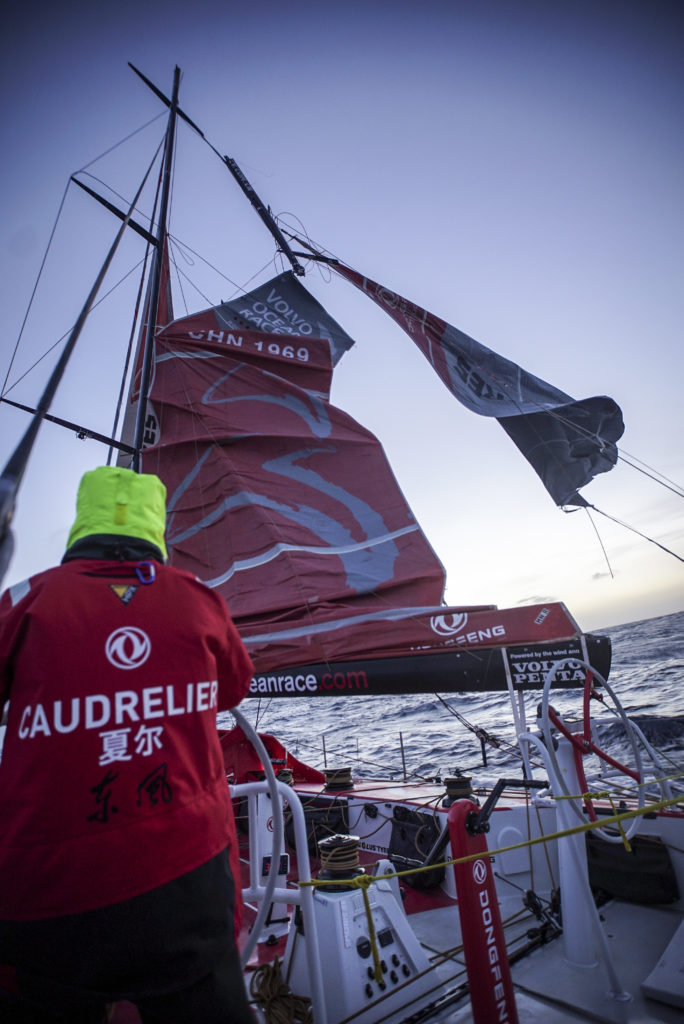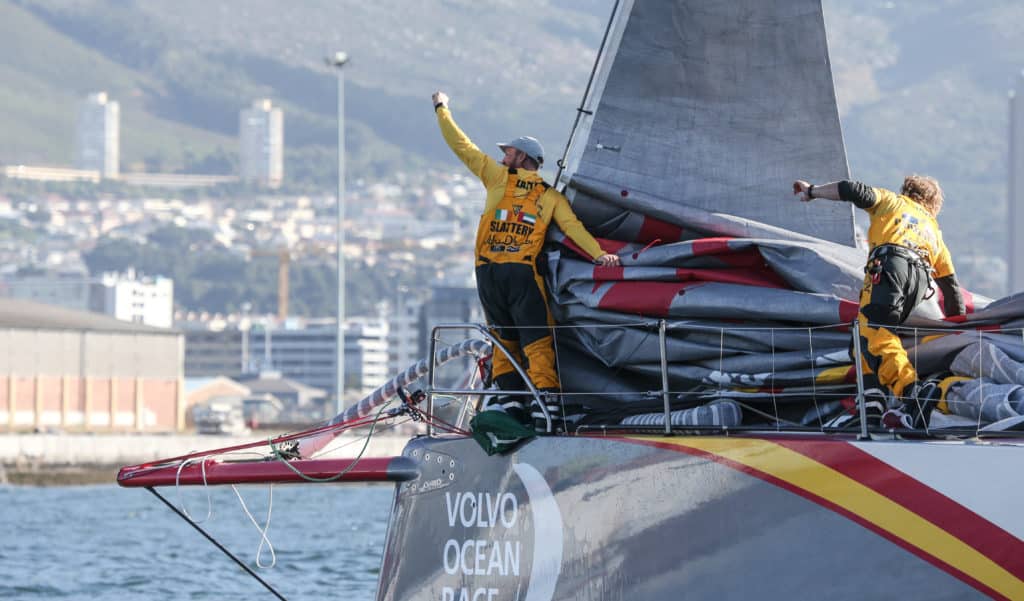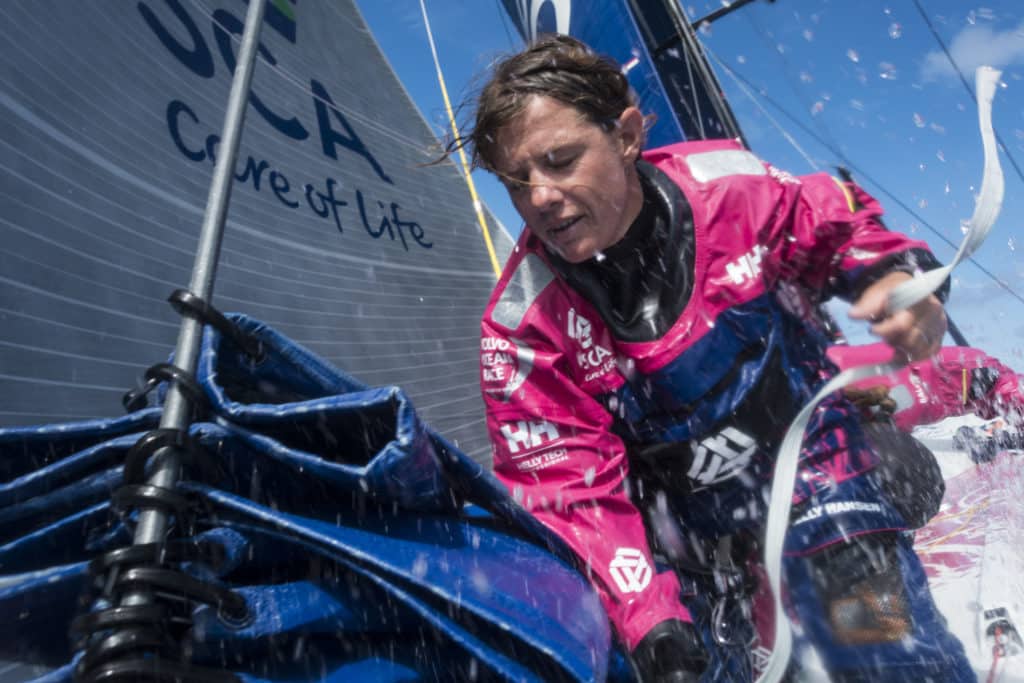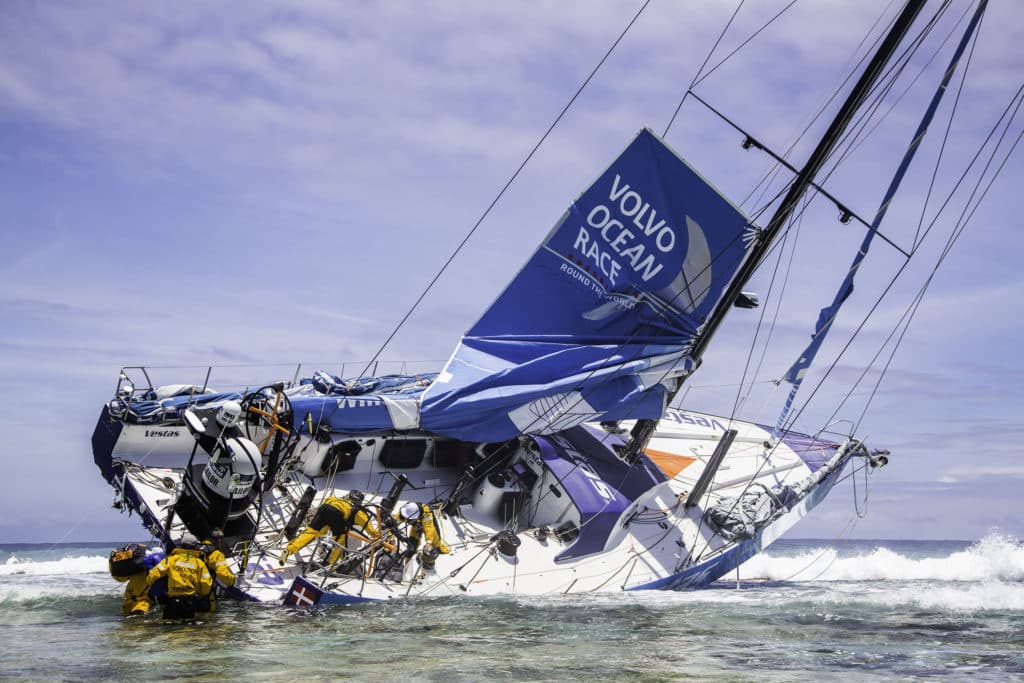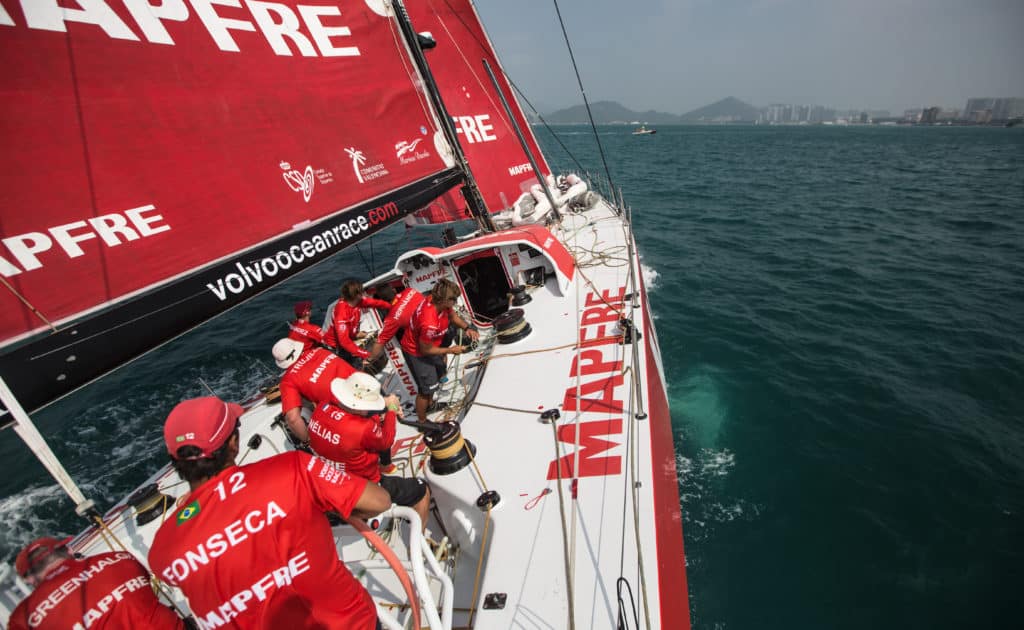It’s the only race of its kind, connecting five continents, over roughly 40,000 thousand ocean miles. A nine-month endurance test for six teams and nearly 40 professional sailing athletes attempting to conquer themselves and everything the ocean and their competitors can throw at them. Starting in Alicante, Spain in October of 2014 and concluding in Gothenburg, Sweden, in June 2015, 70 percent of the racecourse will be complete by the time they sail past Newport’s Castle Hill. One-design is the great equalizer—the boats the same, the sails the same—but because of the human spirit and the unpredictable nature of the sea, the results are never the same.
Leg 1: Alicante, Spain, to Cape Town, South Africa
Distance: 6,487 nautical miles
Order of finish: Abu Dhabi, Dongfeng, Brunel, Alvimedica, Vestas Wind, SCA, Mapfre
Best 24-hour run: Dongfeng @ 541.7 nm
Before the race started in October 2014, Abu Dhabi Ocean Racing was billed as the team to beat. Expertly prepared with a crew stacked with race veterans, the entry led by Englishman Ian Walker cemented its status with leg 1 win of merely 12 minutes. The surprise performance of the leg went to the squad on Dongfeng Race Team, which breathed fire on Walker’s heels all the way into the wind shadow of Cape Town’s Table Mountain.
The perceived handicap of its inexperienced Chinese crewmembers proved not be; at times, they were the fastest team on the water. Despite substantial equipment issues, Dongfeng skipper Charles Caudrelier made the statement that it was, in fact, his team to watch.
“We might not have much experience in the Volvo Ocean Race, but my men know how to fight and they fight for every percent,” said Caudrelier. “We were not favorites, but I also knew we could do great things.”
The leg turned out to be quicker and easier than expected, with swift passages through the historically windless doldrums, and one of the tamest Southern Ocean segments that Walker and others had ever experienced. Gear breakages were minimal, and new teams were still learning how to efficiently get the most from their boats and sails. With a win in the Cape Town In-Port Race, Abu Dhabi was on a roll.
Leg 2: Cape Town to Abu Dhabi
Distance: 6,125 miles
Order of finish: Brunel, Dongfeng, Abu Dhabi, Mapfre, Alvimedica, SCA
Best 24-hour run: Mapfre @ 517.4 nm
Could they? Would they establish supremacy early on, by sailing into their hometown stopover with another win? That was the question laid before Ian Walker and his team before Leg 2, into the Indian Ocean and north into the Gulf of Oman.
Virtually sailing within eyesight of each other northward into the Indian Ocean, dodging wind- less holes and submerged sea mounts, there was day after day of routine sailing until the race’s big shock: Team Vestas Wind running aground on a remote island north of Mauritius, shipwrecking the Dutch entry and reminding the competitors of the perils of ocean racing.
Skipper Chris Nicholson and his crew awaited their eventual rescue, with Team Alvimedica remaining nearby on standby. Meanwhile, the front-runners carried on to another nail-biting conclusion—this one going to Team Brunel, which piped Dongfeng only hours from the finish. Again, the boats finished within hours of each other, further validating the new one-design era of the race.
“I’ve always said, it’s better to be lucky than good, but we’ve been good this leg as well so it’s nice to win this one. It could have been an easy leg to finish last,” said Brunel’s skipper Bouwe Bekking after finishing. “It’s really nice to get the scores, but the team did a fantastic job. We sailed the boat much better than in the first leg. So, that’s the nicest feeling of all.”
Leg 3: Abu Dhabi to Sanya
Distance: 4,642 nm
Order of finish: Dongfeng, Abu Dhabi, Alvimedica, Mapfre, Brunel, SCA
Best 24-hour run: Abu Dhabi Ocean Racing @ 337.7 nm
At this stage, a tie for first on the leader board between Abu Dhabi Ocean Racing and Dongfeng Race Team had all but wiped out preconceived notions of who was fastest, but one thing was becoming evidently clear: it was Dongfeng that was sailing their boat best, and there was nothing to stop them in their quest to be first into their hosted stopover.
With a long, slow exit through the Straits of Hermuz, and some of the fastest sailing yet before reaching the Straits of Malacca, the warm- water, high-speed sailing had smiles on all faces, especially on Dongfeng, which entered the straits with a generous lead that they held until the end. Dongfeng’s victory marked the first time any Chinese sailor had won a leg in the Volvo Ocean Race’s 41-year history. The team’s two Chinese sailors onboard, Liu Xue and Cheng Ying, received a hometown heroes welcome.
“It was the most stressful race of my life,” said Caudrelier on the docks. “We took the lead on the first day, and we had to keep it because we had to arrive first here. It was very important for me and for the project, so we are proud. One year ago, we were here and we were discovering the Chinese sailors, who were rookies, and now they win the leg—it’s just fantastic. This is everything I wanted, but I didn’t dare think about. It’s a team job and you can’t win without a strong team.”
Abu Dhabi followed three hours later, and finally the young sailors on Team Alvimedica sailed their way to a podium finish.
“It was a combination of things, our boatspeed was better in certain conditions, our crew was gelling better and we were working in a more efficient way,” said co-skipper Charlie Enright. “The guys really dug deep short-tack- ing up the coast of Vietnam to maintain our position across the South China Sea into Sanya.”
Leg 4: Sanya, China to Auckland
Distance: 5,264 nm
Order of finish: Mapfre, Abu Dhabi, Dongfeng, Alvimedica, Brunel, SCA
Best 24-hour run: Team Brunel @ 460 nm
The quickest way to Auckland from Sanya is to sail away from Auckland for days on end. Contrary to the straightest, shortest distance, the winning move is often to sail well east before hooking into the trades, and then making a beeline south across the Equator. But that’s not always the case, as evidenced in this stunningly tactical leg in which Team SCA and Team Brunel broke away from the fleet early on. It was the first time the fleet had seen a separation by hundreds of miles, only to come together and finish within seven hours of each other. Team Brunel was initially rewarded with its breakaway gamble, building a 100-mile lead, but stumbled at the Equator with a few “tactical mistakes.”
Mapfre, with co-skipper Xabi Fernández in charge, seized the opportunity. The Spaniards had lost communications for three days due to antennae problems, preventing them from receiving full weather data onboard, but
in the end, it didn’t matter: The Spaniards were able to stave of a strong push from Abu Dhabi over the final 24 hours, and scored their first leg victory by a mere 4 minutes, 25 seconds.
Leg 5: Auckland to Itajai, Brazil
Distance: 6,776
Order of finish: Abu Dhabi, Mapfre, Alvimedica, Brunel, SCA, Dongfeng (retired)
Best 24-hour run: Abu Dhabi Ocean Racing @ 549 nm
Postponed in Auckland while Tropical Cyclone Pam ran its course, the sailors grew anxious. The fastest way across the Southern Ocean is with the assistance of an eastward moving storm, but this one was too powerful. Instead, the fleet left on Pam’s coattails and into the most brutal conditions of the race thus far. The sailing was fast, but it was unforgiving, and smartly so, a few teams, including Alvimedica, had bolstered their rosters with Southern Ocean veterans.
The fleet set out on March 18 with Mapfre leading the charge, and the following day, feeling the departing storms lingering effects, the teams were having a hard time settling into routines. “Now that we’re actually
here, everyone’s either green or exhausted and often both,” wrote Amory Ross, Alvimedica’s onboard reporter. “The sea state is really confused and it makes doing any- thing abnormally difficult. We talk a lot about racing these boats, the demands and skills it requires. But when the conditions are like they are now, simply living takes considerable effort too.”
But they lived through the blistering sprint south to established ice gates—waypoints set to keep the fleet from iceberg hazards— and as conditions worsened, so too did reports from the boats. Four teams reported crash jibes, which come unexpectedly and create all sorts of havoc on the boat, especially at night, as it happened for the women of SCA who permanently damaged their most important headsail, leaving them reeling at the back of the fleet.
For days on end, as the leaders approached Cape Horn, it was simply a battle of attrition and preservation, and it was Dongfeng who looked set to take the Horn by storm, until its mast broke one-third of the way from the top. They were only two hundred miles from rounding and, understandably, devastated.
“We were not pushing a lot, less than the others, as I really wanted to take care of the boat,” reported Caudrelier. “We are going to lose a lot of points. I always tell to my guys, you don’t do the Volvo Ocean Race with- out meeting a big problem. Last time (on Groupama), we broke the mast on the same leg and we won the race, so the game is not over for us. We will lose some points but we will still be on the podium, and we are going to attack and try to come back. It’s not the end of the world, just one leg hopefully.”
Dongfeng’s darkness gave Team Alvimedica its brightest moment. A calculated run across the Southern Ocean saw them to theHorn frst, 12 minutes ahead of Abu Dhabi Racing. The celebration would be short, however,
as days later, the race’s overall leader chipped away the miles, assumed the lead, and sailed into Itajai to re-establish its position atop the leader board.
“This is a hugely satisfying result,” said Walker upon arrival. “You always have to be wary of the Southern Ocean, and this time was no different. We saw some of the most ferocious conditions any of us has seen, but we stayed strong and made it through. Our hearts go out to the Dongfeng crew. It’s hard to know where the red line is for these boats until you cross it—and by then, it’s too late. We wish them the very best of luck in getting back in the race as soon as possible.”
THE REMAINING LEGS
Leg 6: Itajai to Newport
Distance: 5,010 nm
Leg 7: Newport to Lisbon
Distance: 2,800 nm
Leg 8: Lisbon to Lorient
Distance: 647 nm
Leg 9: Lorient to Gothenburg
Distance: 1,600 nm
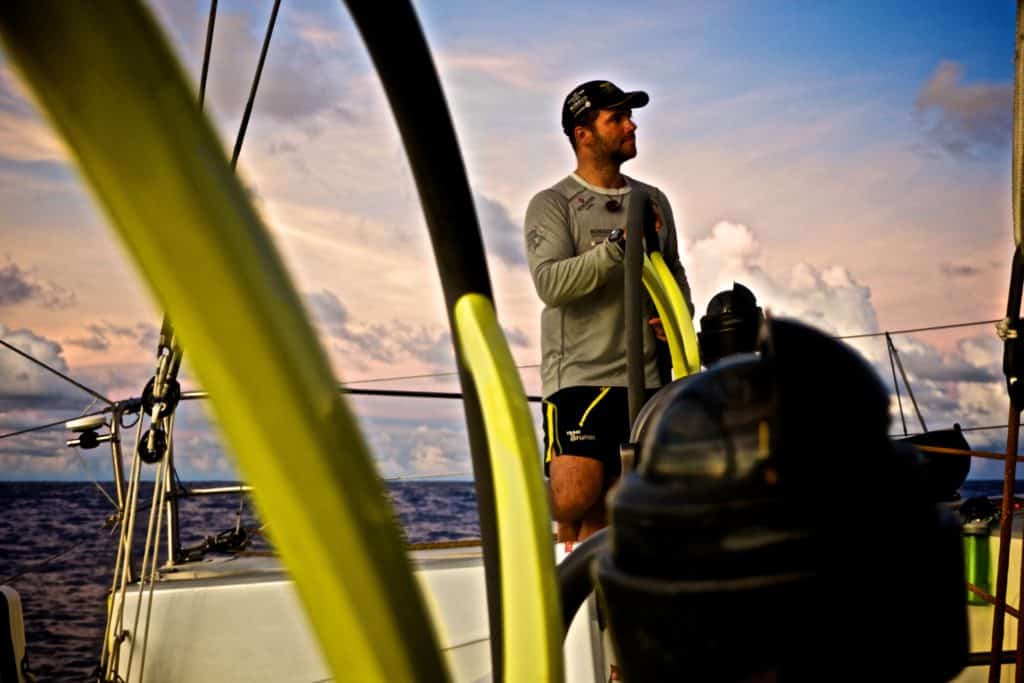
Volvo Ocean Race 2014-15 – Leg 4 to Auckland
